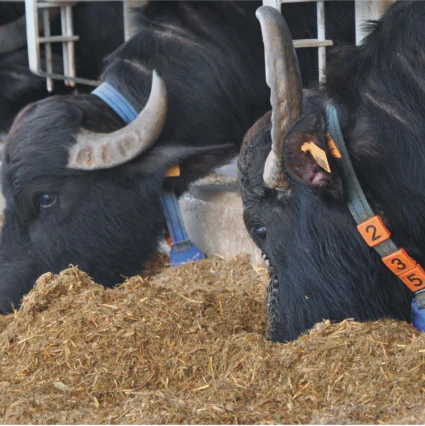Repeat Breeding Syndrome in Dairy Cattle: Management & Treatment

An animal’s capacity for reproduction is one of the most critical components of a dairy herd. Dairy producers make the most money when they produce one crop of calves annually. For the dairy industry to be lucrative, the two most crucial aspects are good reproduction and good production.
Parturition, the main event in reproduction, marks the beginning of a buffalo’s productive life. The dairy cattle then require consistent cycles of ovulation and calving to start the lactation that is the foundation of their abundant life. Therefore, the reproductive efficiency of dairy animals is essential for a successful dairy farming operation. Thus, to ensure optimal reproduction, the reproductive issues that ultimately result in an inability to reproduce must be identify and check as soon as possible to get the optimal profit on the farm.
Causes of Repeat Breeding (RB) Syndrome in Cattle
Possible causes include genetics, the environment, infections, and abnormal ovarian function. These etiological factors ultimately lead to either unsuccessful fertilization or embryonic mortality, which encourages repeat breeding.
The leading causes of RB are:
Genetics: Parental anomalies in the chromosome or genetic flaws that arise during differentiation may hurt fertility. For instance, Repeat Breeding in buffaloes with chromosomal abnormalities like translocation 1/29 or trisomy X has been observe. Inbreeding and old gametes can cause genetic abnormalities that result in repeated breeding. The frequency of repeat breeding in cattle varies depending on the breed.
Age: Age is typically reported to be detrimental to fertility, and repeat breeding is more common in older buffalo in Haryana. After the first or second delivery, dairy cows’ fertility tends to increase, but from the fourth and fifth delivery, it tends to diminish.
Repeated estrous cycles and uterine infection: The uterine environment supports healthy embryonic development. Therefore, any condition or abnormality, such as uterine infections, endometritis, pyometra, metritis, etc., has a negative impact on the embryo’s survival and leads to embryonic death, which is also one of the leading causes of repeated breeding. The uterine infections adversely affect the uterine and cervical postpartum involution, follicular development, embryo mortality, and repeat estrus rates.
Genital tract anatomical flaws: The reproductive system provides a favorable environment for oocyte development, sperm transportation, fertilization, and implantation. These structures’ anatomical or functional changes may force gestational failure and further breeding.
Poor ovarian function: One of the significant causes of infertility in dairy buffalo is the issue of ovarian cysts. Repeat breeding occurs in cattle due to cystic ovarian degeneration (COD). Anoestrus and delayed ovulation are also related to this issue. Repeat breeding syndrome may be triggered by luteal insufficiency leading to progesterone shortage.
Artificial insemination: Any irregular procedure, including bull preparation, artificial vagina preparation, semen collection, processing, and storage, and erroneous insemination to the oestrus stage, may lead to repeat breeding. Animals that are not inseminate at the proper time may not conceive. We should inseminate buffalo in Haryana by the AM-PM rule, meaning that if a buffalo goes into heat in the morning, she should be inseminated that evening. If she goes into heat in the evening, she should be inseminate the following day. Mid- to late-heat insemination is recommend for exotic/crossbred animals. It is preferable to do a second insemination 12 to 24 hours after the first one in crossbreed animals.
Precautions to Address the Issue of Repeated Breeding
Repeat breeding is a fairly common issue with dairy cattle, costing farmers money and time. Prevention is preferable rather than treatment. The following safety measures can be implement to reduce the likelihood of repeat breeding in buffaloes.
- Keep your breeding records up to date.
- Avoid crowding, especially while AI is in effect.
- Mineral combination supplementation ought to make up 2% of the daily feed.
- Give the animals access to pristine water to drink.
- During the summer, give the dairy cattle as much cool weather as possible, especially the hybrid animals. The animals will stay cool and healthy during the summer by being heavily plant around the farm, misting water, bathing, and painting the roof.
- Insemination should not be perform on animals with ovaries, fallopian tubes, or congenital uterus abnormalities. The subsequent generations contract these ailments. Therefore, such animals ought to be put to death right away.
- Animals that are underweight (less than 250 kg), malnourished, or anemic should not ever be inseminate.
- Dairy cattle should not be overfed oil seed cakes because doing so increases the risk of fetal death.
- Do not feed dairy cows grains, green feed, or wheat straw contaminated with mold.
- Avoid using a bull to test for inbreeding with his daughter. To prevent inbreeding, keep accurate records and rotate the breeding bull among dairy farmers at least every third year.
- Animals should never be inseminate during the heat cycle that has met the oestrus/post-oestrus bleeding stage.
- Only administer hormonal therapy when necessary.
Conclusion
As a dairy farmer, you must protect your cattle from any disease. If you are looking for any assistance, MeraPashu 360 is a one-stop solution where you can get advice & treatment from experts by sitting in the comfort of your home. Visit their official website to know more.